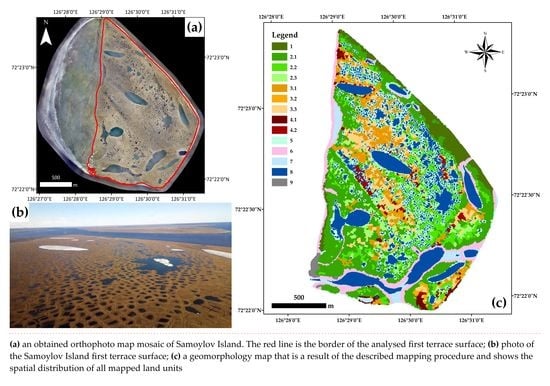Assessment of the Ice Wedge Polygon Current State by Means of UAV Imagery Analysis (Samoylov Island, the Lena Delta)
Abstract
1. Introduction
2. Study Area
3. Materials and Methods
3.1. UAV Imaging and Photogrammetry
3.2. GIS Analysis and Geomorphological Mapping
4. Results
- Incipient polygons (IP): These represent drained polygons with flat centers, an absence of rims, and rather shallow troughs (10–20 cm) above ice wedges (Figure 3 and Figure A1a). Incipient polygons are the start point of polygon development and their further degradation. They usually arise on newly exposed ground, for example, on the bottom of drained lakes [12].
- Low-centered polygons (LCP): In accordance with French [2], Mackay [12], Liljedahl et al. [5], and Nitzbon et al. [6], we designated this type of polygon as having the lowest elevation point in the center (Figure 4 and Figure A1b). Elevated rims, or ramparts, outline polygon centers. Nevertheless, the elevation of troughs was greater than polygon centers. Besides low-centered polygons (2.1), we have revealed low-centered polygons with water-filled centers (2.2) and with water-filled troughs (2.3), because the presence of water can change the hydrological regime of polygon nets and lead to the onset of thermokarst activity. This process is described in the aforementioned models of polygon degradation.
- Intermediate-centered polygons (ICP): We have recognized polygons with troughs, which subsided below the polygon centers, but with elevated rims (Figure 5 and Figure A1c). Polygons with these topographic characteristics were named “intermediate-centered” in Nitzbon et al. [6], although Root [42], Mackay [12], and French [2] named this type as walled or fortress polygons. In any case, the topography of ICP usually represents a further step of degradation after LCP. As for LCP, we subdivided ICP into three land units: intermediate-centered polygons (3.1), intermediate-centered polygons with water-filled centers (3.2), and intermediate-centered polygons with water-filled troughs (3.3). It should be noted that in some cases, polygons of land units 2.3 and 3.3 also have water-filled centers. However, we decided that the presence of water in troughs is more important, as connected troughs can lead to the destruction of polygon rims and the lateral expansion of ponds, which have appeared already or will do so in the future.
- High-centered polygons (HCP): We have named polygons with flat centers, which are higher than rims and troughs, as HCP (Figure 6 and Figure A1d). In some cases, rims of HCP are slightly elevated (5–10 cm), but are not higher than the polygon center. Nevertheless, the distinctive feature of HCP is the absence of any depression in the polygon center. This topographic characteristic does not allow for the development of ponds in the polygon centers. Depths of HCP troughs vary from 0.2–0.3 m to 1–1.2 m in different parts of the island. We also recognized high-centered polygons (4.1) and high-centered polygons with water-filled troughs (4.2).
- Collapsed polygons (CP) (Figure 7): We observed destroyed polygons in the wettest parts of the island. Ponds of these polygons have merged and identification of the original type of polygon was problematic. In addition, we assigned polygon remnants around and in water bodies as CP.
- Slopes: All slopes were easily recognizable in all morphometry schemes, especially in aspect schemes (Figure 8). When the slope angle increases to >2°, solifluction processes occur, changing the microtopography and destroying polygons. Moreover, slopes have a distinct vegetation cover, which simplifies their recognition in orthophotos. Some IP have been observed on slopes, but we concluded that slope processes play the main role in the topography change of this territory. Furthermore, polygons located on slopes were either degraded already, or will be degraded by solifluction over time. Therefore, these polygons did not follow the models for polygon evolution.
- Valleys (Figure 8): Floods erode valleys during the spring season. Valleys subside due to thermal and fluvial erosion and were overlapped by a thin layer of sandy or silty sediments from water currents. Some signs of polygon presence were observed on the flat bottom parts of valleys. However, floods cover these surfaces annually and their influence precluded the stabilization or growth of ice wedges. Therefore, we have not found any IP on valley bottoms.
- Lakes and other water bodies (Figure 7 and Figure 8): Clear distinctions and differences between merged polygon ponds and small thermokarst lakes, which developed in troughs via polygon degradation, were problematic. The largest lakes often connected with surrounding shallow ponds, and borders between these water bodies were also difficult to determine. We have therefore unified large lakes, and merged polygon ponds and water-filled troughs, if they eroded more than half of adjacent polygons, as one land unit. We have identified all water bodies in orthophotos.
- The Samoylov Island research station: A number of station buildings are located in the south-western part of the study area. The presence of infrastructure complicates our geomorphological analysis of this terrain, therefore we excluded this terrain from further assessment.
5. Discussion
6. Conclusions
Funding
Acknowledgments
Conflicts of Interest
Appendix A
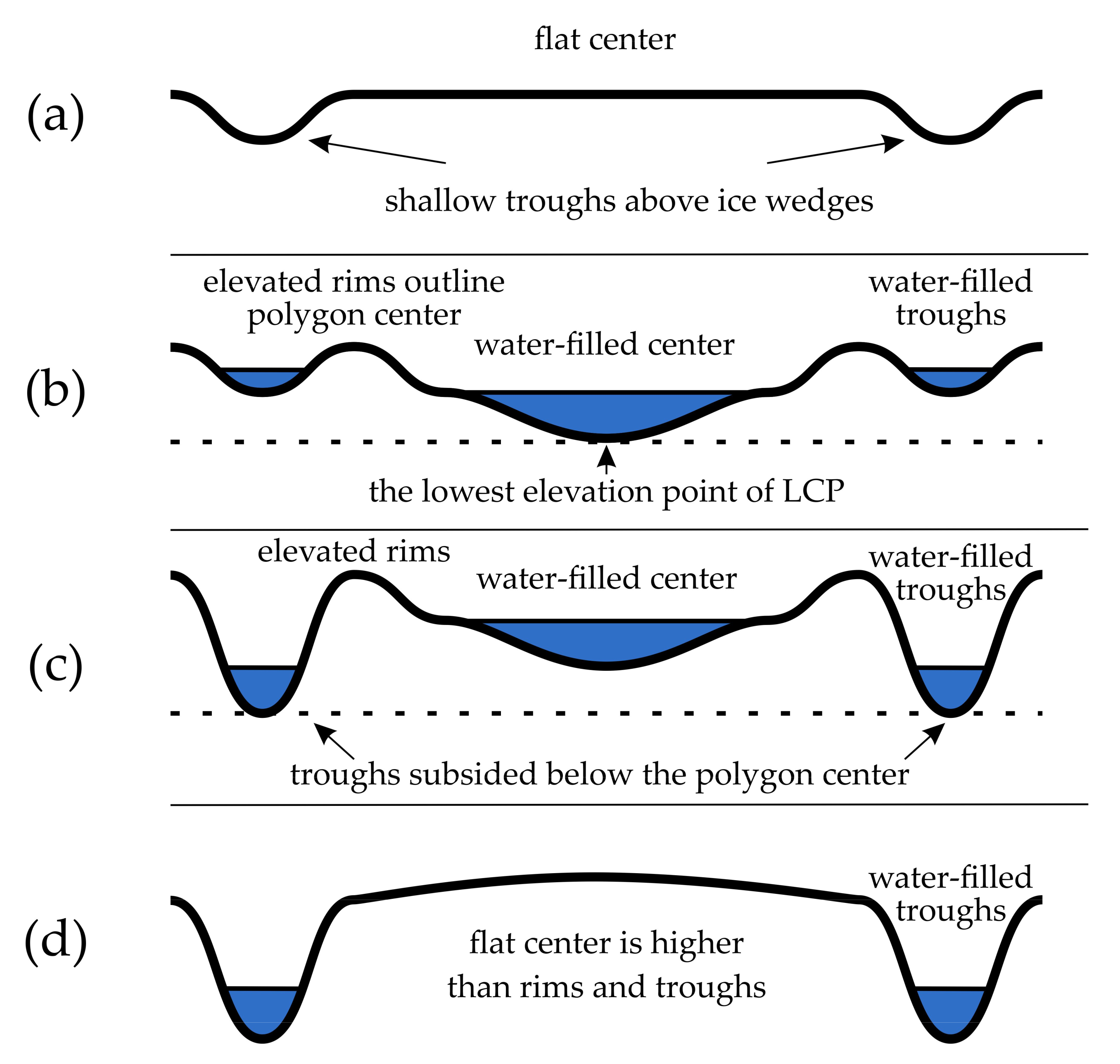
References
- Walker, D.A.; Raynolds, M.K.; Daniëls, F.J.; Einarsson, E.; Elvebakk, A.; Gould, W.A.; Katenin, A.E.; Kholod, S.S.; Markon, C.J.; Melnikov, E.S.; et al. The circumpolar Arctic vegetation map. J. Veg. 2005, 16, 267–282. [Google Scholar] [CrossRef]
- French, H.M. The Periglacial Environment, 3rd ed.; John Wiley & Sons: West Sussex, UK, 2007; p. 458. [Google Scholar]
- Leffingwell, E.K. Ground-ice wedges: the dominant form of ground-ice on the north coast of Alaska. J. Geol. 1915, 23, 635–654. [Google Scholar] [CrossRef]
- Lachenbruch, A.H. Mechanics of thermal contraction cracks and ice-wedge polygons in permafrost. In GSA Special Papers; Geological Society of America: Boulder, CO, USA, 1962. [Google Scholar] [CrossRef]
- Liljedahl, A.K.; Boike, J.; Daanen, R.P.; Fedorov, A.N.; Frost, G.V.; Grosse, G.; Hinzman, L.D.; Iijma, Y.; Jorgenson, J.C.; Matveyeva, N.; et al. Pan-Arctic Ice-Wedge Degradation in Warming Permafrost and Its Influence on Tundra Hydrology. Nat. Geosci. 2016, 9, 312–318. [Google Scholar] [CrossRef]
- Nitzbon, J.; Langer, M.; Westermann, S.; Martin, L.; Aas, K.S.; Boike, J. Pathways of ice-wedge degradation in polygonal tundra under different hydrological conditions. Cryosphere 2019, 13, 1089–1123. [Google Scholar] [CrossRef]
- Jorgenson, M.T.; Shur, Y.L.; Pullman, E.R. Abrupt increase in permafrost degradation in Arctic Alaska. Geophys. Res. Lett. 2006, 33, 2–5. [Google Scholar] [CrossRef]
- Kanevskiy, M.; Shur, Y.; Jorgenson, T.; Brown, D.R.N.; Moskalenko, N.; Brown, J.; Walker, D.A.; Raynolds, M.K.; Buchhorn, M. Degradation and stabilization of ice wedges: implications for assessing risk of thermokarst in Northern Alaska. Geomorphology 2017, 297, 20–42. [Google Scholar] [CrossRef]
- Jorgenson, M.T.; Kanevskiy, M.; Shur, Y.; Moskalenko, N.; Brown, D.R.N.; Wickland, K.; Striegl, R.; Koch, J. Role of ground ice dynamics and ecological feedbacks in recent ice wedge degradation and stabilization. J. Geophys. Res. Earth Surf. 2015, 120, 2280–2297. [Google Scholar] [CrossRef]
- Abolt, C.J.; Young, M.H.; Atchley, A.L.; Harp, D.R. Microtopographic control on the ground thermal regime in ice wedge polygons. Cryosphere 2018, 12, 1957–1968. [Google Scholar] [CrossRef]
- Aas, K.S.; Martin, L.; Nitzbon, J.; Langer, M.; Boike, J.; Lee, H.; Berntsen, T.K.; Westermann, S. Thaw processes in ice-rich permafrost landscapes represented with laterally coupled tiles in a land surface model. Cryosphere 2019, 13, 591–609. [Google Scholar] [CrossRef]
- Mackay, J.R. Thermally induced movements in ice-wedge polygons, western arctic coast: A long-term study. Geogr. Phys. Quatern. 2000, 54, 41–68. [Google Scholar] [CrossRef]
- Zimov, S.A. Climate change: permafrost and the global carbon budget. Science 2006, 312, 1612–1613. [Google Scholar] [CrossRef] [PubMed]
- Tamocai, C.; Canadell, J.G.; Schuur, E.A.G.; Kuhry, P.; Mazhitova, G.; Zimov, S. Soil organic carbon pools in the Northern circumpolar permafrost region. Global Biogeochem. Cycles 2009, 23, 1–11. [Google Scholar] [CrossRef]
- Iwasaki, S.; Desyatkin, A.R.; Filippov, N.V.; Desyatkin, R.V.; Hatano, R. Carbon stock estimation and changes associated with thermokarst activity, forest disturbance, and land use changes in Eastern Siberia. Geoderma Reg. 2018, 14, e00171. [Google Scholar] [CrossRef]
- Anisimov, O.; Belolutskaya Grigoriev, A.I.; Kokorev, V.; Oberman; Reneva; Strelchenko, S.A.; Streletskiy, D.; Shiklomanov, N. Major Natural and Social-Economic Consequences of Climate Change in the Permafrost Region: Predictions Based on Observations and Modeling; Greenpeace: Moscow, Russia, 2010; p. 44. (In Russian) [Google Scholar]
- Streletskiy, D.; Anisimov, O.; Vasiliev, A. Permafrost Degradation. In Snow and Ice-Related Hazards, Risks, and Disasters; Shroder, J.F., Haeberli, W., et al., Eds.; Academic Press: Boston, MA, USA, 2015. [Google Scholar]
- Mora, C.; Lousada, M.; Pina, P.; Bandeira, L.; Vieira, G. Evaluation of the use of very high resolution aerial imagery for accurate ice-wedge polygon mapping (Adventdalen, Svalbard). Sci. Total Environ. 2017, 615, 1574–1583. [Google Scholar] [CrossRef]
- Fraser, R.H.; Olthof, I.; Lantz, T.C.; Schmitt, C. UAV Photogrammetry for Mapping Vegetation in the Low-Arctic. Arct. Sci. 2016, 2, 79–102. [Google Scholar] [CrossRef]
- Armstrong, L.; Lacelle, D.; Fraser, R.H.; Kokelj, S.; Knudby, A. Thaw Slump Activity Measured Using Stationary Cameras in Time-Lapse and Structure-from-Motion Photogrammetry. Arct. Sci. 2018, 4, 827–845. [Google Scholar] [CrossRef]
- Van der Sluijs, J.; Kokelj, V.S.; Fraser, H.R.; Tunnicliffe, J.; Lacelle, D. Permafrost Terrain Dynamics and Infrastructure Impacts Revealed by UAV Photogrammetry and Thermal Imaging. Remote Sens. 2018, 10, 1734. [Google Scholar] [CrossRef]
- Huang, L.; Liu, L.; Jiang, L.; Zhang, T. Automatic Mapping of Thermokarst Landforms from Remote Sensing Images Using Deep Learning: A Case Study in the Northeastern Tibetan Plateau. Remote Sens. 2018, 10, 2067. [Google Scholar] [CrossRef]
- Riihimäki, H.; Luoto, M.; Heiskanen, J. Estimating Fractional Cover of Tundra Vegetation at Multiple Scales Using Unmanned Aerial Systems and Optical Satellite Data. Remote Sens. Environ. 2019, 224, 119–132. [Google Scholar] [CrossRef]
- Saito, H.; Iijima, Y.; Basharin, N.I.; Fedorov, A.N.; Kunitsky, V.V. Thermokarst development detected from high-definition topographic data in Central Yakutia. Remote Sens. 2018, 10, 1579. [Google Scholar] [CrossRef]
- Kravtsova, V.I.; Mit’kinykh, N.S. Mouths of World Rivers in the Atlas of Space Images. Water Resour. 2011, 38, 1–17. [Google Scholar] [CrossRef]
- Degtyarev, V. Lena River Delta (Russia). In The Wetland Book: II: Distribution, Description, and Conservation; Finlayson, C.M., Milton, R., Prentice, C., Davidson, N.C., Eds.; Springer Netherlands: Dordrecht, The Netherlands, 2018; pp. 1451–1456. [Google Scholar]
- Grigoriev, M.N. Criomorphogenesis in the Lena Delta; Permafrost Institute Press: Yakutsk, Russia, 1993; p. 176. (In Russian) [Google Scholar]
- Schwamborn, G.; Rachold, V.; Grigoriev, M.N. Late Quaternary Sedimentation History of the Lena Delta. Quat. Int. 2002, 89, 119–134. [Google Scholar] [CrossRef]
- Bolshiyanov, D.; Makarov, A.; Savelieva, L. Lena River Delta Formation during the Holocene. Biogeosciences 2015, 12, 579–593. [Google Scholar] [CrossRef]
- Schirrmeister, L.; Grosse, G.; Schnelle, M.; Fuchs, M.; Krbetschek, M.; Ulrich, M.; Kunitsky, V.; Grigoriev, M.; Andreev, A.; Kienast, F.; et al. Late Quaternary Paleoenvironmental Records from the Western Lena Delta, Arctic Siberia. Palaeogeogr. Palaeoclimatol. Palaeoecol. 2011, 299, 175–196. [Google Scholar] [CrossRef]
- Schirrmeister, L.; Grosse, G.; Schwamborn, G.; Andreev, A.A.; Meyer, H.; Kunitsky, V.V.; Kuznetsova, T.V; Dorozhkina, M.V; Pavlova, E.Y.; Bobrov, A.A.; et al. Late Quaternary History of the Accumulation Plain North of the Chekanovsky Ridge (Lena Delta, Russia): A Multidisciplinary Approach. Polar Geogr. 2003, 27, 277–319. [Google Scholar] [CrossRef]
- Wetterich, S.; Kuzmina, S.; Andreev, A.A.; Kienast, F.; Meyer, H.; Schirrmeister, L.; Kuznetsova, T.; Sierralta, M. Palaeoenvironmental Dynamics Inferred from Late Quaternary Permafrost Deposits on Kurungnakh Island, Lena Delta, Northeast Siberia, Russia. Quat. Sci. Rev. 2008, 27, 1523–1540. [Google Scholar] [CrossRef]
- Grigoriev, N.F. The temperature of permafrost in the Lena delta basin–deposit conditions and properties of the permafrost in Yakutia. Yakutsk 1960, 2, 97–101. (In Russian) [Google Scholar]
- Boike, J.; Nitzbon, J.; Anders, K.; Grigoriev, M.; Bolshiyanov, D.; Langer, M.; Lange, S.; Bornemann, N.; Morgenstern, A.; Schreiber, P.; et al. A 16-Year Record (2002–2017) of Permafrost, Active-Layer, and Meteorological Conditions at the Samoylov Island Arctic Permafrost Research Site, Lena River Delta, Northern Siberia: An Opportunity to Validate Remote-Sensing Data and Land Surface, Snow, and Permafrost Models. Earth Syst. Sci. Data 2019, 11, 261–299. [Google Scholar] [CrossRef]
- Zubrzycki, S.; Kutzbach, L.; Grosse, G.; Desyatkin, A. Organic Carbon and Total Nitrogen Stocks in Soils of the Lena River Delta. Biogeosci. 2013, 10, 3507–3524. [Google Scholar] [CrossRef]
- Mackay, J.R. The Mackenzie Delta Area; Geographical Branch Memoir, no. 8; Queen’s printer: Ottawa, ON, Canada, 1963; p. 202. [Google Scholar]
- Hussey, K.M.; Michelson, R.W. Tundra relief features near Point Barrow, Alaska. Arctic 1966, 19, 162–184. [Google Scholar] [CrossRef]
- Romanovskiy, N.N. Formation of Polygonal-Wedge Structures; Nauka SSSR: Novosibirsk, Russia, 1977; p. 212. (In Russian) [Google Scholar]
- Kumar, J.; Collier, N.; Bisht, G.; Mills, R.T.; Thornton, P.E.; Iversen, C.M.; Romanovsky, V. Modeling the spatiotemporal variability in subsurface thermal regimes across a low-relief polygonal tundra landscape. Cryosphere 2016, 10, 2241–2274. [Google Scholar] [CrossRef]
- Grant, R.F.; Mekonnen, Z.A.; Riley, W.J.; Wainwright, H.M.; Graham, D.; Torn, M.S. Mathematical modelling of Arctic polygonal tundra with Ecosys: 1. Microtopography determines how active layer depths respond to changes in temperature and precipitation. J. Geophys. Res. Biogeosci. 2017, 122, 3161–3173. [Google Scholar] [CrossRef]
- Bisht, G.; Riley, W.J.; Wainwright, H.M.; Dafflon, B.; Fengming, Y.; Romanovsky, V.E. Impacts of microtopographic snow redistribution and lateral subsurface processes on hydrologic and thermal states in an arctic polygonal ground ecosystem: a case study using ELM-3D v1.0. Geosci. Model Dev. 2018, 11, 61–76. [Google Scholar] [CrossRef]
- Root, J.D. Ice-Wedge Polygons, Tuktoyaktuk Area, North –West Territories; Geology Survey of Canada: Ottawa, ON, Canada, 1975; p. 181. [Google Scholar]
- Muster, S.; Langer, M.; Heim, B.; Westermann, S.; Boike, J. Subpixel heterogeneity of ice-wedge polygonal tundra: a multi-scale analysis of land cover and evapotranspiration in the Lena River Delta, Siberia. Tellus Ser. B Chem. Phys. Meteorol. 2012, 64, 1–20. [Google Scholar] [CrossRef]
- Boike, J.; Kattenstroth, B.; Abramova, K.; Bornemann, N.; Chetverova, A.; Fedorova, I.; Fröb, K.; Grigoriev, M.; Grüber, M.; Kutzbach, L.; et al. Baseline characteristics of climate, permafrost and land cover from a new permafrost observatory in the Lena River Delta, Siberia (1998–2011). Biogeosciences 2013, 10, 2105–2128. [Google Scholar] [CrossRef]
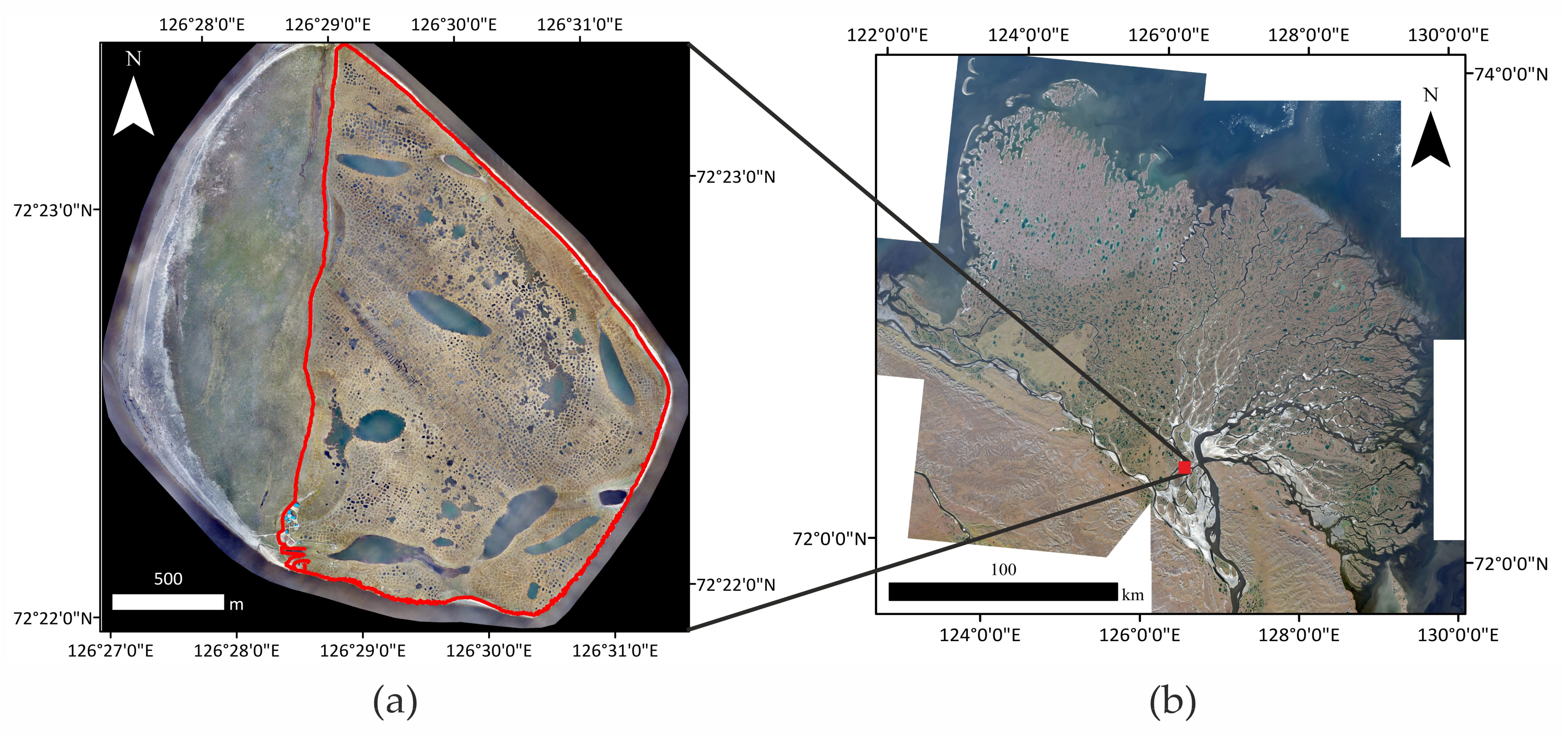
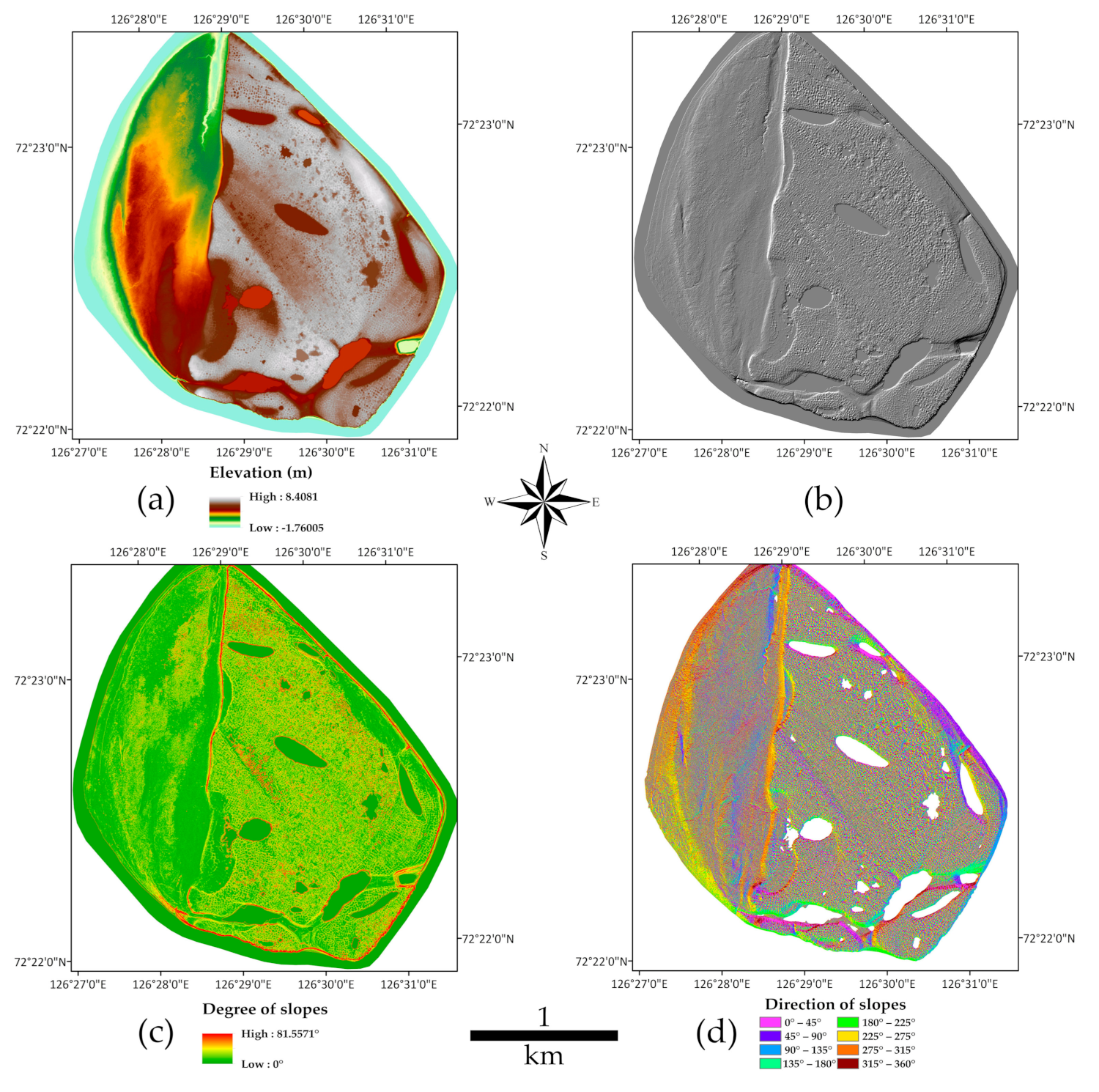
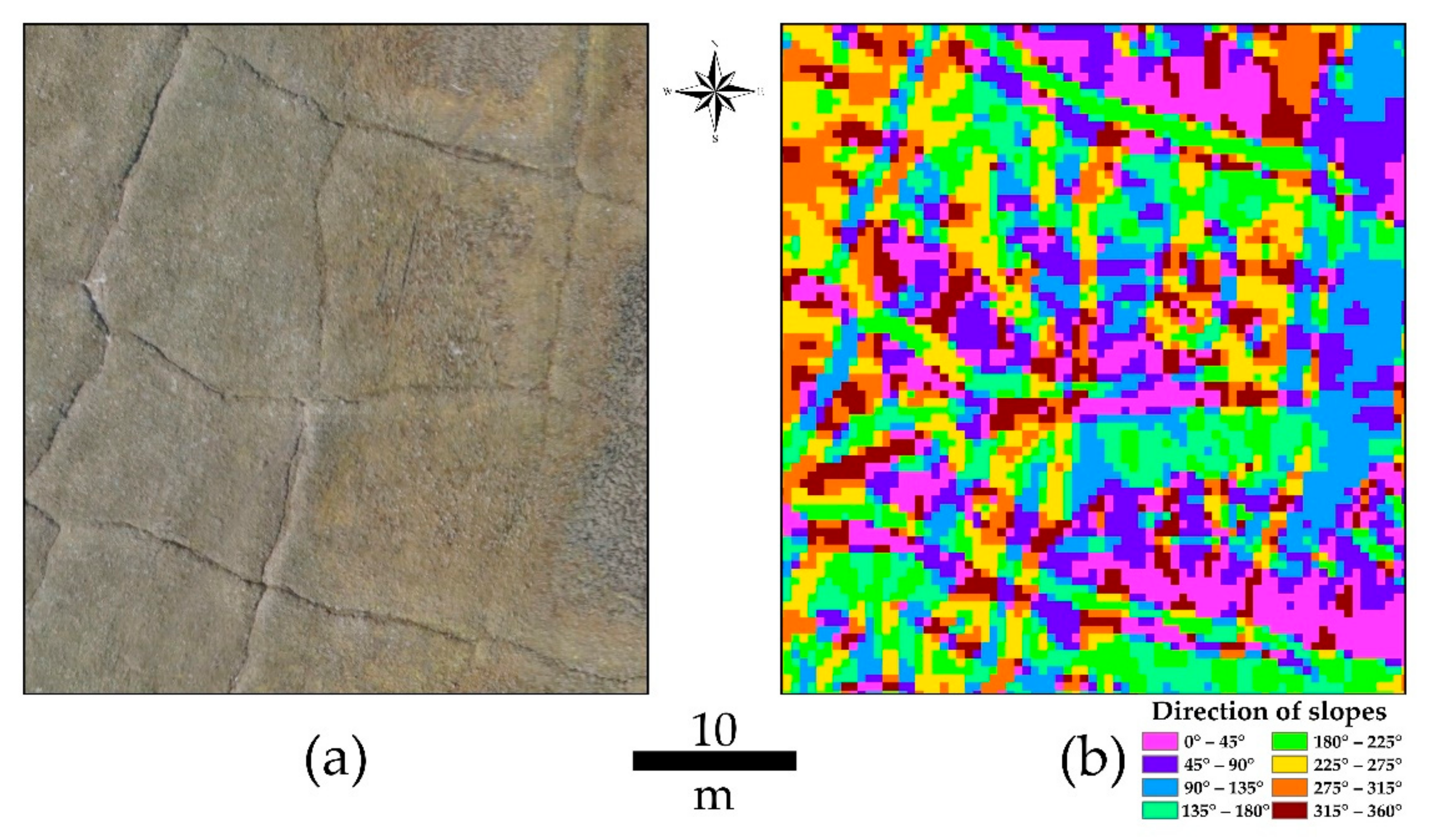
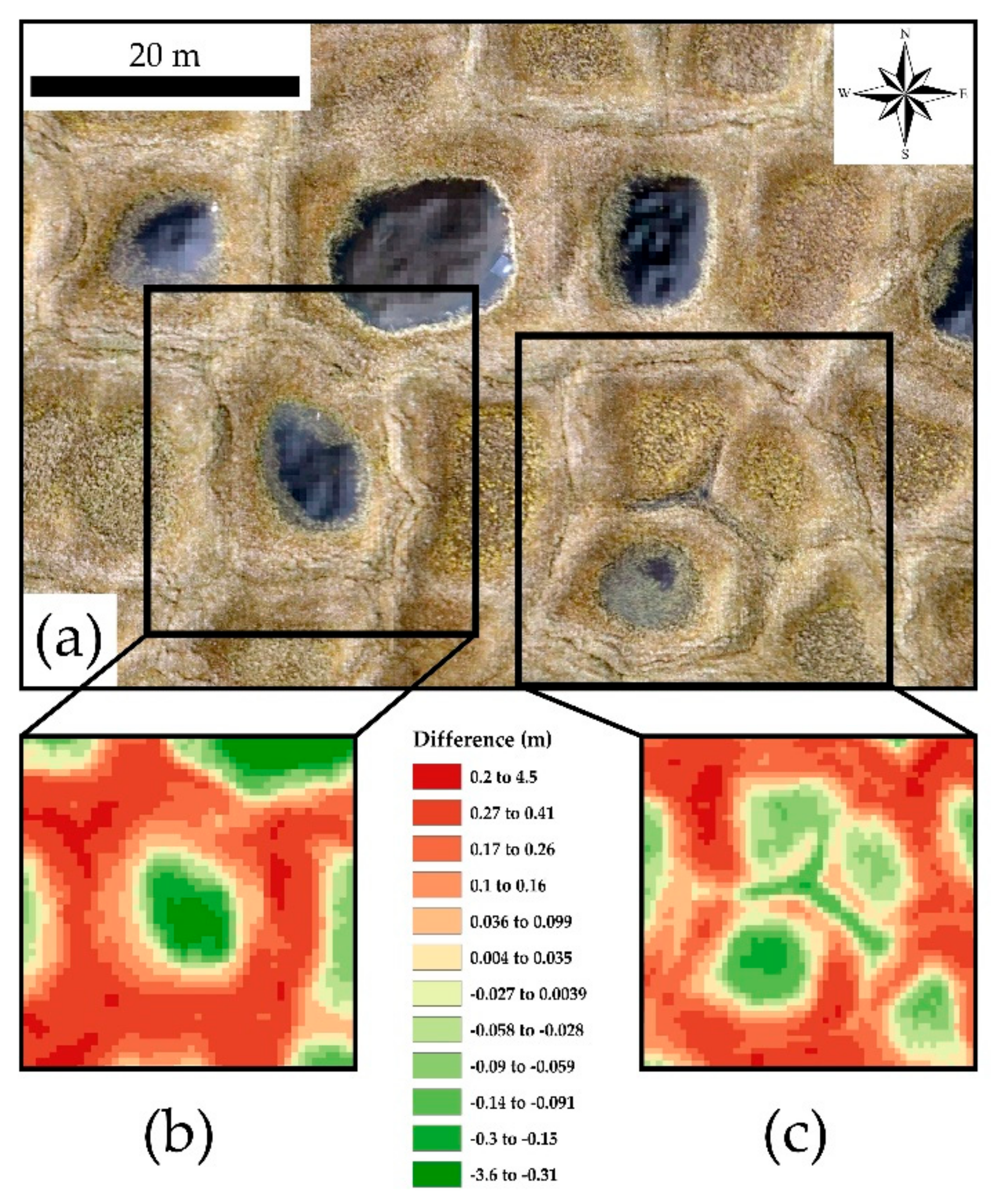
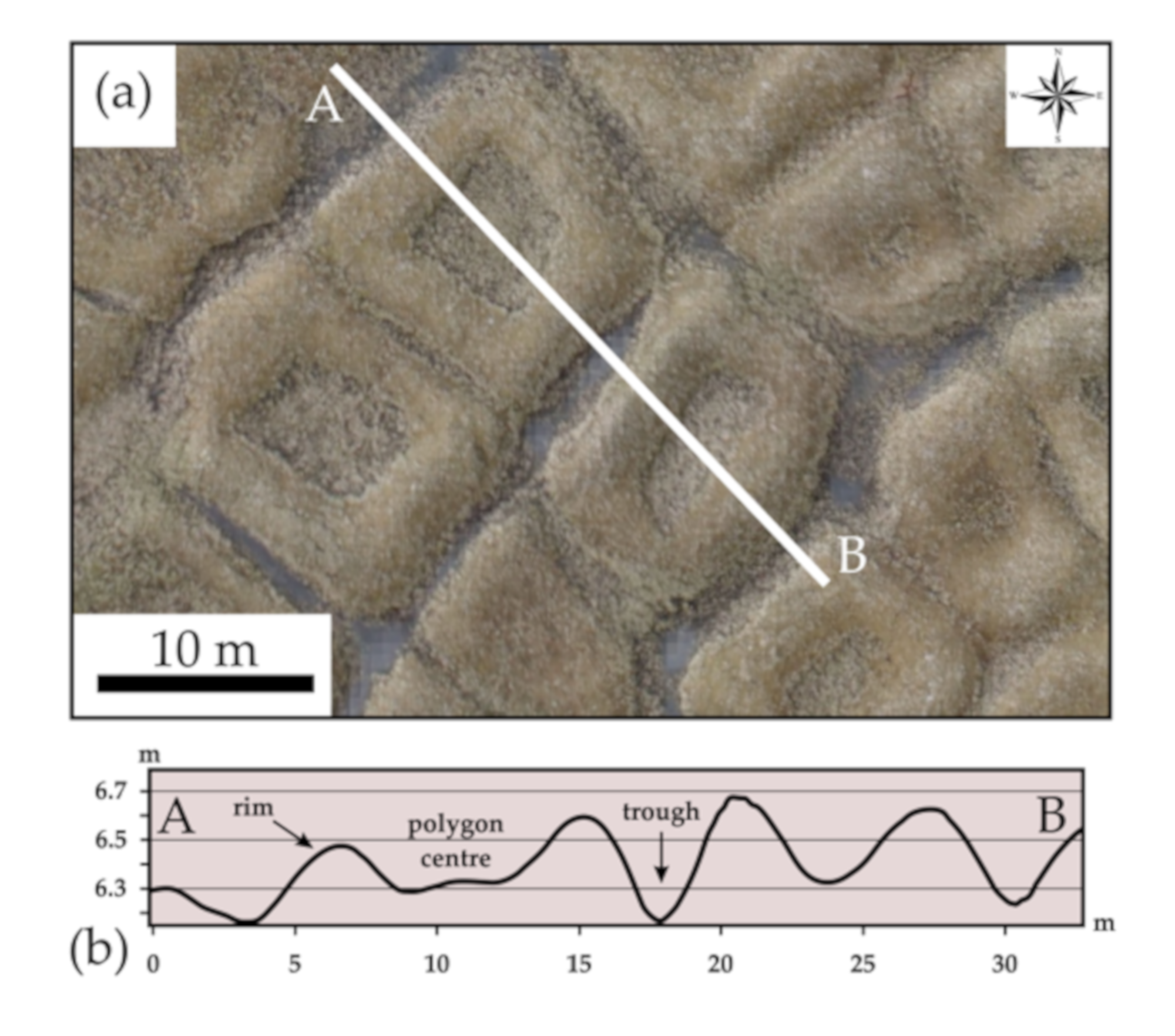
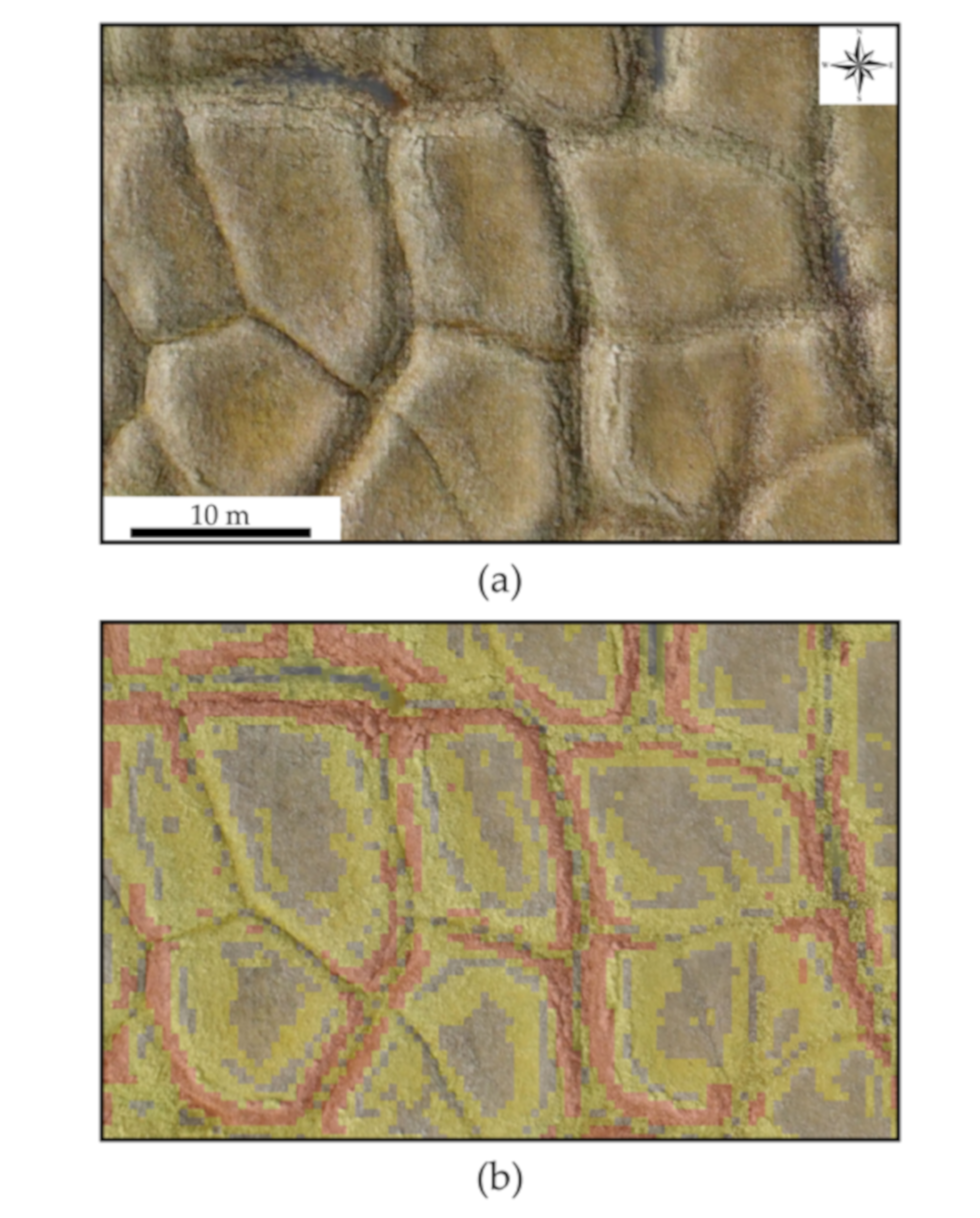
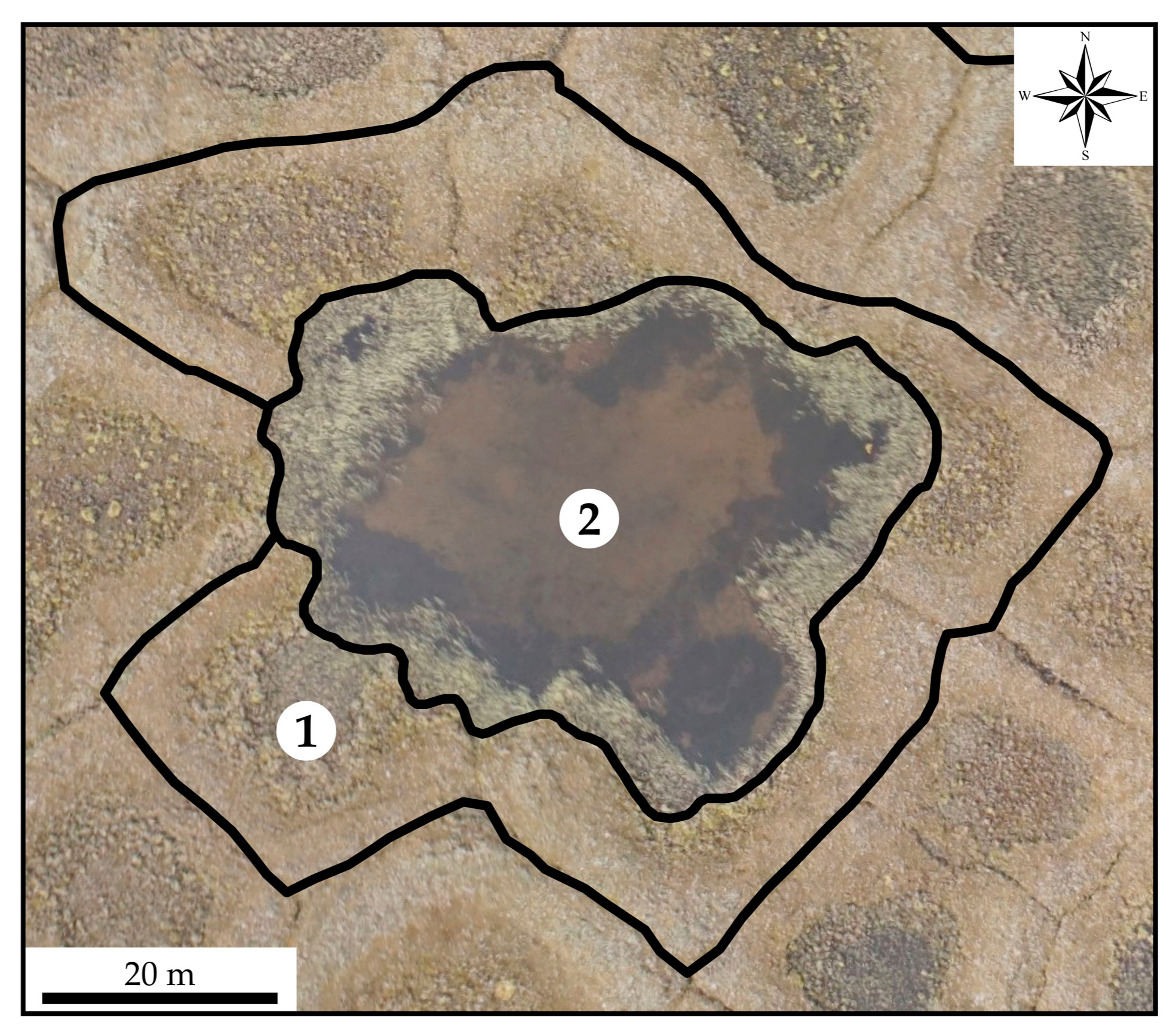
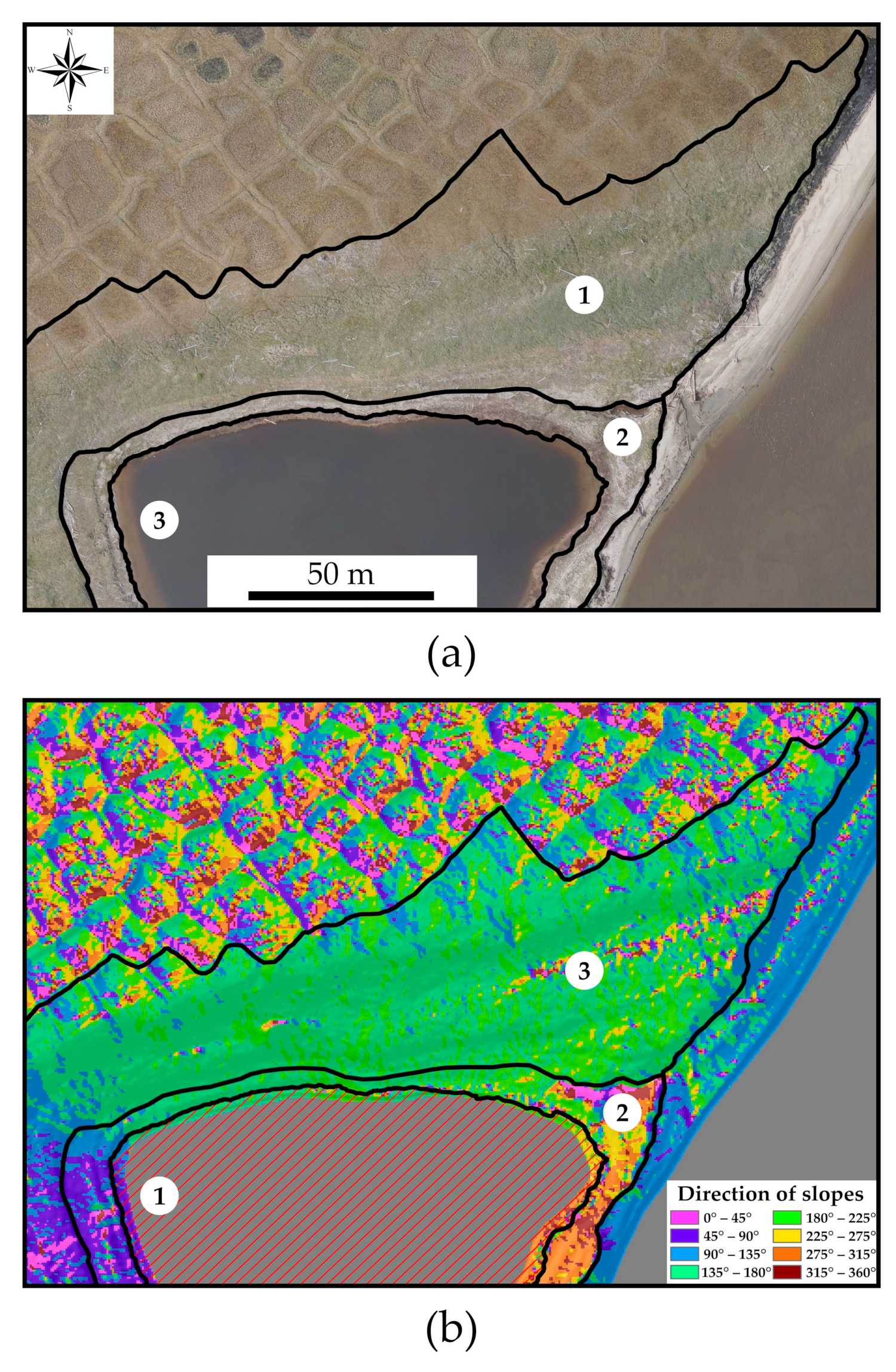
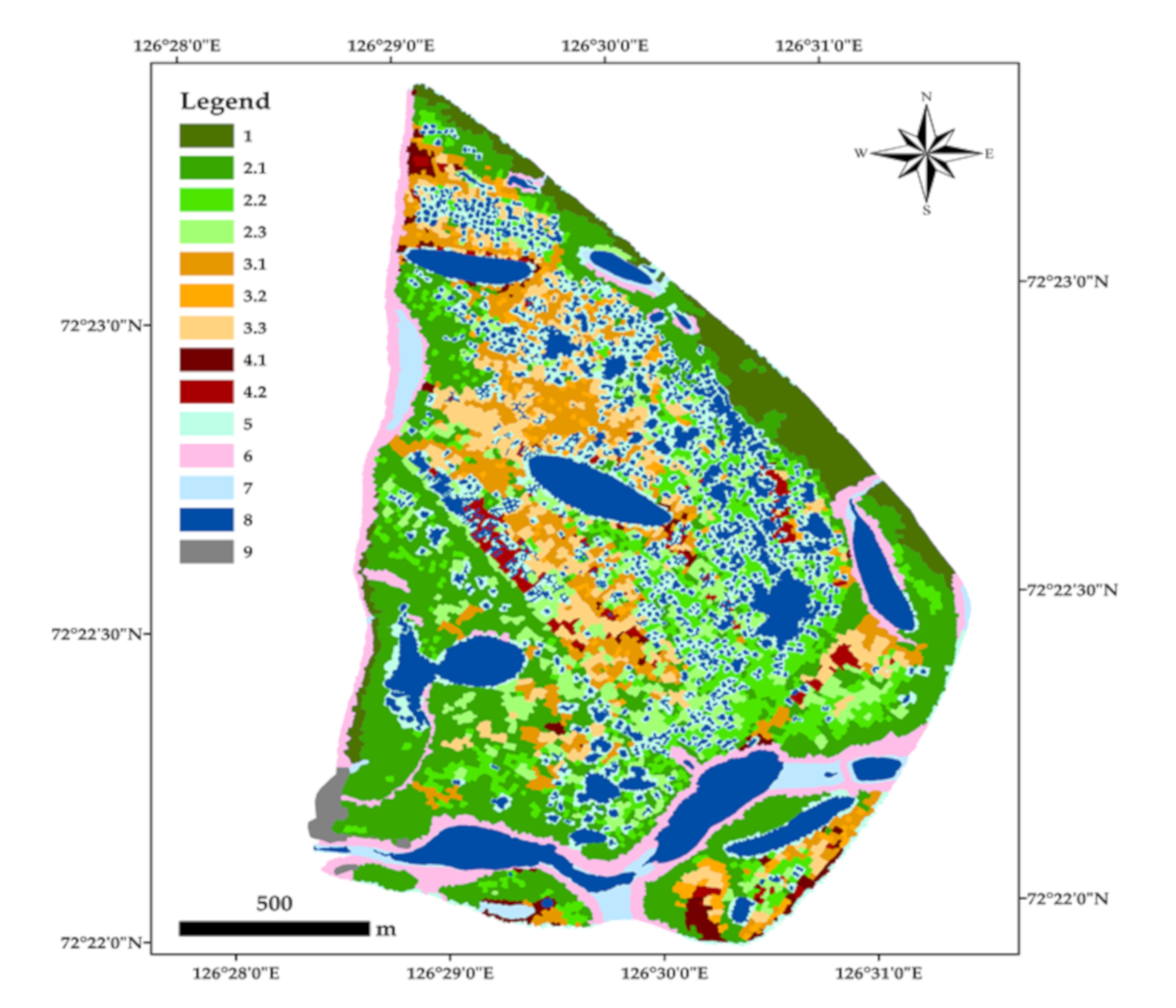
| Land Units | m2 | % | |
|---|---|---|---|
| 1 | Incipient polygons (IP) | 136,242 | 4.82% |
| 2.1 | Low-centered polygons (LCP) | 658,787 | 23.30% |
| 2.2 | LCP with water-filled centers | 218,520 | 7.73% |
| 2.3 | LCP with water-filled troughs | 168,144 | 5.95% |
| 3.1 | Intermediate-centered polygons (ICP) | 213,881 | 7.55% |
| 3.2 | ICP with water-filled centers | 46,979.1 | 1.66% |
| 3.3 | ICP with water-filled troughs | 174,479 | 6.17% |
| 4.1 | High-centered polygons (HCP) | 39,804.1 | 1.41% |
| 4.2 | HCP with water-filled troughs | 44,199.2 | 1.56% |
| 5 | Collapsed polygons (CP) | 325,495 | 11.51% |
| 6 | Slopes | 193,354 | 6.84% |
| 7 | Valleys | 66,706.4 | 2.36% |
| 8 | Lakes and other water bodies | 541,209 | 19.14% |
© 2019 by the author. Licensee MDPI, Basel, Switzerland. This article is an open access article distributed under the terms and conditions of the Creative Commons Attribution (CC BY) license (http://creativecommons.org/licenses/by/4.0/).
Share and Cite
Kartoziia, A. Assessment of the Ice Wedge Polygon Current State by Means of UAV Imagery Analysis (Samoylov Island, the Lena Delta). Remote Sens. 2019, 11, 1627. https://doi.org/10.3390/rs11131627
Kartoziia A. Assessment of the Ice Wedge Polygon Current State by Means of UAV Imagery Analysis (Samoylov Island, the Lena Delta). Remote Sensing. 2019; 11(13):1627. https://doi.org/10.3390/rs11131627
Chicago/Turabian StyleKartoziia, Andrei. 2019. "Assessment of the Ice Wedge Polygon Current State by Means of UAV Imagery Analysis (Samoylov Island, the Lena Delta)" Remote Sensing 11, no. 13: 1627. https://doi.org/10.3390/rs11131627
APA StyleKartoziia, A. (2019). Assessment of the Ice Wedge Polygon Current State by Means of UAV Imagery Analysis (Samoylov Island, the Lena Delta). Remote Sensing, 11(13), 1627. https://doi.org/10.3390/rs11131627




